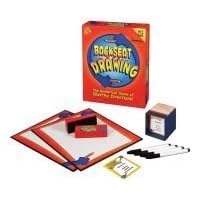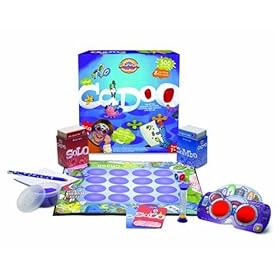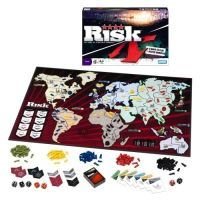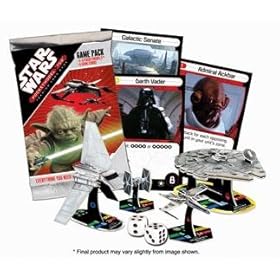
We stopped at Target this evening to look for something completely unrelated (a cake pan, if you must know - yes, a new shaped cake is incoming), and while passing through the toy section, I looked over their selection of board games. It was pretty poor.
I know I’ve mentioned that I’m a game junkie. I buy, uh, everything game related. I’ve come across a few pretty darn good games in my time, certainly enough to bother writing about here. And since I’ve noticed that my visitors are looking for such things, I thought I would take a little time to answer some questions and point to some real winners.
Before we get started, I’ll answer the main question posed that leads people to my site: Is it ok to buy your boyfriend a boardgame? The answer is yes. There is a catch, though. Either you must know that he plays them already, or you must play them with him. If not, don’t bother, or he’ll end up with a really cool game he’ll never get to play. Or maybe it would inspire him to find a group to play with. Who knows?!
Now, on with the games!
Carcassonne
 Carcassonne is typical of the kind of board game I love to play. It’s got a ton of pieces, rules that are reasonably simple to follow, capability for expansion, and tons of fun play potential.
Carcassonne is typical of the kind of board game I love to play. It’s got a ton of pieces, rules that are reasonably simple to follow, capability for expansion, and tons of fun play potential.
The basic idea of Carcassonne is to construct a countryside made of farms and castles. The main pieces of the game are square tiles which are randomly selected one at a time during your turn. You place the tiles on the table next to existing tiles so that the edges match and extend either a castle wall or a road.
When you place your tiles, you can also place one of seven little tokens (in the shape of a wooden “man” of your player color) on the tile. If that man is on the castle section of the tile when any player completes the castle’s walls, you get a certain number of points for each tile within that wall, and you get to reclaim your “man”. You can also get points for road segments, cathedrals, and for farmland, depending on how you place your token within a tile. When you run out of tiles, you total the points, and the player with the most points wins.
It sounds complex, but once you play a couple of times, it’s pretty easy. Strategy is high. This game is not Sorry and has no pop-a-matic bubble. It’s actually very fun – one of my favorites.
There are some great expansion sets available for it, too. Inns and Cathedrals, Hunters and Gatherers (technically, it’s a full game, gut it’s played the same), Traders and Builders, Abbey and Mayor, Princess and Dragon, King and Scout…
Backseat Drawing
 If you’re looking to level the playing field in your family Pictionary games for the people without great artistic skill, Backseat Drawing is your title. I first saw this game as it was being demoed at the Origins Game Fair.
If you’re looking to level the playing field in your family Pictionary games for the people without great artistic skill, Backseat Drawing is your title. I first saw this game as it was being demoed at the Origins Game Fair.
In the game, two teams compete to be the first to guess the thing that is written on the play card. Like in Pictionary only one person knows the thing, but unlike Pictionary, that person does not draw. Instead, they give instructions to someone else using basic geometry to try to draw that thing. The drawer can guess, as well as any other teammates present.
The game has two levels of difficulty, and each topic card is translated into multiple languages, making it a good play even in multi-lingual settings.
The aMAZEing Labyrinth
 There are actually two versions of this game. One is a “board” game, and the other is a card game. Technically though, they both have cards. And the board game doesn’t really have a board. Anyway… I have the card game, and I assume the board game works similarly.
There are actually two versions of this game. One is a “board” game, and the other is a card game. Technically though, they both have cards. And the board game doesn’t really have a board. Anyway… I have the card game, and I assume the board game works similarly.
In the card game, you place square tiles with pictures of a Labyrinth (like Carcassonne!) on the table so that the edges match. If you manage to connect two tiles with the same treasure picture via a labyrinth path, you can collect that treasure. The person with the most treasure when the tiles run out wins the game.
Simple and fun. Abby (7) and I play this game now and then, and she has no trouble.
Cadoo
 If you’ve ever been to Starbucks, you’ve probably seen the Cranium games. Cadoo is made by the same people, and is geared for kids. I’ve put it on this list because sometimes there are folks, even adults, in the family who won’t or can’t play board games because they’re too hard. This one isn’t “easy”, but it’s not reliant on endless trivia (Trivial Pursuit) or drawing skills (Pictionary) but it’s not conversely random and devoid of interest.
If you’ve ever been to Starbucks, you’ve probably seen the Cranium games. Cadoo is made by the same people, and is geared for kids. I’ve put it on this list because sometimes there are folks, even adults, in the family who won’t or can’t play board games because they’re too hard. This one isn’t “easy”, but it’s not reliant on endless trivia (Trivial Pursuit) or drawing skills (Pictionary) but it’s not conversely random and devoid of interest.
Cadoo is your basic board game. You move the pieces around, land on color-coded spots, and do the thing that corresponds to the spot. Each color represents a different kind of activity. Sometimes you model with clay, sometimes you answer a simple question, sometimes you even have to go on a scavenger hunt in the house. In all, it’s pretty fun, and easy enough for Abby to do. You will need to be able to read (or be on a team with someone who can) to play this game.
Risk
 I worry about this recommendation. Risk is a classic game. It’s something that you just don’t mess with. But they have messed with the rules for the most recent edition, and I don’t have it to know what the real differences are, since I’m married to my beautiful anniversary set with metal game pieces.
I worry about this recommendation. Risk is a classic game. It’s something that you just don’t mess with. But they have messed with the rules for the most recent edition, and I don’t have it to know what the real differences are, since I’m married to my beautiful anniversary set with metal game pieces.
Nonetheless, Risk remains your classic world conquest game. You roll dice, gain troops, attack your enemies, make and break alliances, and rule the world.
Games typically take about 8 days to complete. Perhaps that’s what they’ve changed in the new rules.
Risk is the classic “I’ve got nothing to do but play war with my buddies, eat jalapeno cheese dip, and talk trash about how I’m gonna kick your ass” game. Axis and Allies might be a better game, but Risk is an undeniable classic. Not owning this game is like not owning Monopoly. How do you live with yourself?
Settlers of Catan
 Risk may be the classic game in this set, but Settlers of Catan says something completely different about you. Owning Settlers says, “Yeah, you play board games. I play Settlers. Therefore, you suck.” Of course, being good at it is a completely different matter.
Risk may be the classic game in this set, but Settlers of Catan says something completely different about you. Owning Settlers says, “Yeah, you play board games. I play Settlers. Therefore, you suck.” Of course, being good at it is a completely different matter.
In this game, you build cities and roads in an attempt to monopolize resources on the small island of Catan. You spend resources gained by building your initial settlements on specific hexagonal tiles. You can spend these to build new roads or settlements, or to upgrade your settlements into cities. Do this while avoiding (and moving) the robber baron, who prevents a player from gaining resources derived from a specific tile.
This game has so many unique pieces to lose, you should buy two. You will also forget how to play between games. That’s normal.
Talisman
Games Wordshop made Talisman, but now it’s produced by Fantasy Flight Games. The new version has “cross-graded” art – it doesn’t look like Games Workshop style anymore, but that doesn’t make it “better”. I haven’t seen the new version first hand (since it hasn’t been released yet), but it seems to have all of the same stuff, even if things have changed a bit. The 2007 version in the black box seems quite a bit different, and perhaps lacking.
The premise is simple. There’s a dragon. It’s your job to slay it and rule the world.
You pick a character at the start of the game. Each character has certain unique abilities. You use these abilities to travel the world (move your piece around the board) defeating monsters in battle to increase your abilities and eventually kill the dragon. Straightforward fun.
I enjoyed painting the original set of miniatures that came with the game. I’m not sure what comes with this most recent edition. Even if there isn’t an opportunity to paint the minis, the game is pretty good fantasy fun.
Quandary
You may have a hard time finding this game. It’s simple, fast, and fun, and that’s why it’s a classic during the Holidays when family and friends that aren’t as hard-core as me want to play a game.
In this game, you lay down tiles with numbers, setting the value of different types of colored tile bars. With each number tile played, you take a tile bar of any color. When all of the number tiles are played, the game is over. The last number played for each color is the value of that colored tile. So if the last blue number played is 4, then each blue tile is worth 4 points. Whoever has the most points wins.
What’s great is that it’s really easy to explain (perhaps easier when you can see the board and pieces), but it leads to some interesting dynamics of brief alliances and fleeting logic. And it’s so easy to pick up and play, anyone can pick up on these nuances within the first couple games.
Descent - Journeys in the Dark
 Descent is almost not a board game. It’s almost a role-playing game. In fact, it takes the pretense out of roleplaying by kind of ignoring it. Still, it leaves behind a nice miniatures game.
Descent is almost not a board game. It’s almost a role-playing game. In fact, it takes the pretense out of roleplaying by kind of ignoring it. Still, it leaves behind a nice miniatures game.
The game comes with characters and monsters in statistics and hordes of miniatures. There are adventure books, player books, and scads of dungeon tiles. The books explain how to use the figures to go on a dozen or more adventures. Expansion packs give you more miniatures, more dungeon, more adventure books.
The game is of very high quality, but pretty dense. I’ve yet to find anyone willing and able to put the time in to figure out the game and play it with me. Still, it looks like a lot of fun, and come highly recommended within my secret worldwide cabal of underground game playing enthusiasts.
Star Wars Pocket Model Collectible Card Game
 This is not exactly a board game. I suppose that you could say that a couple of the other games in this list aren’t really board games either. But this one is definitely not a board game. Nonetheless, it’s the only game on this list that you can stuff in a stocking. It’s also the only one with a Star Wars theme.
This is not exactly a board game. I suppose that you could say that a couple of the other games in this list aren’t really board games either. But this one is definitely not a board game. Nonetheless, it’s the only game on this list that you can stuff in a stocking. It’s also the only one with a Star Wars theme.
The Star Wars Pocket Model Collectible Card Game is a game in which you use little plastic cards with cut-outs in them to build models that you can use to play a tabletop game of space battle.
The “technology” that makes this game possible is the cool thing about this game, even if the game is really playable. If the recipient of this game doesn’t ever play it, just assembling the Star Wars ships is a blast.
There are different types of packs that offer different vehicles, each with different powers. If you’re not familiar with collectible card games (CCGs) you should know that each pack has something different in it, just like baseball cards. Each pack has enough for one person to play, but different packs have different stuff. So you might have to buy a few (heh, a “few”) packs of cards to get a Millennium Falcon card.
If you’re not into Star Wars (that would be me), then you might consider one of the other games by WizKids that uses the same card system. Pirates of the Spanish Main is the original game of this type but with really cool card-constructed pirate ships, and Rocketmen is a Buck Rodgers-like space game with faux-futuristic ships.
Bonus: Guillotine
Guillotine is a card game, but not a traditional kind. In this game, you line up various historical figures at the guillotine to have their heads chopped off. Playing certain cards allows you to reorder the line so that on your turn the head whose historical figure is worth the most points is the one to fall into your point basket.
Fun and creative gameplay and an amusing concept make this a great game to give or to receive.


